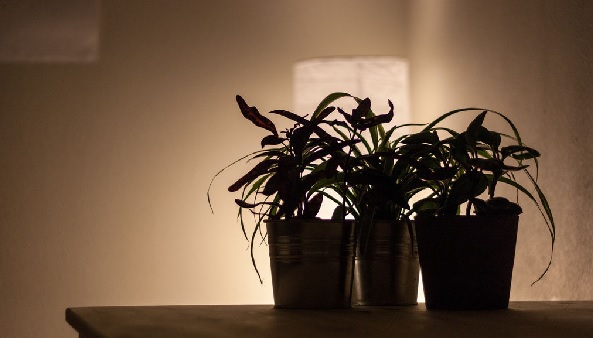Insect Pests Associated with Houseplants
By Chris Williams on June 5, 2013.

Some houseplant pests remain exclusively on the plant and will not be seen unless the plant (especially the underside of leaves) is examined. Below are pests associated with houseplants that can move off of the plant, causing concern for homeowners who can’t figure out where the pests are coming from.
Fungus gnats
These tiny, dark gnats are probably the most common pest associated with houseplants indoors. And they are always associated with overwatered, too wet potting soil. The fly larvae live in the upper layers of the soil where they feed on decaying organic material. The black adult flies that emerge from the pot can be seen running on surfaces in a jerky manner or flying to lights or windows.
The Fix?
Repot the plants in fresh potting soil and cut back on watering, letting the soil dry out completely in between.
Leaf Feeders
There are several pests that infest houseplants, sucking the juices from the leaves and gradually causing the plant to decline and eventually die. Often these pests are already on the plant, either when purchased or when received from a well-meaning friend. Tiny spider mites (often mistaken for bird mites or ticks) will occasionally leave the plant and roam across surfaces. Whiteflies look like very tiny, white moths and will leave the plant and fly weakly if the plant is disturbed.
The Fix?
There are different treatments for pest-infested houseplants, including insecticidal soap, but they don’t always work. If you don’t particularly value the plant, or if it seems too far gone to save, it’s best to simply throw it out.
Ants
When potted plants are kept outside, small ants will often nest in the soil or between the pot and the saucer. They are sometimes forced out during heavy rains or watering, or when the plant is moved inside to a drier environment. Sometimes plants that have never been outside can get ants if they are also infested with whiteflies or aphids or other plant-feeding insects that excrete a sugary substance called “honeydew.” If ants find a source of honeydew, they will trail to the plant to feed on the sticky secretions.
The Fix?
Before moving houseplants back inside, remove the saucers and water them thoroughly to flush out ants. When ants are seeking honeydew, either discard infested plants or treat them with a product that kills the plant-feeding pests.
There are other unique situations where leaf chewers like caterpillars or grasshoppers may hitchhike inside on potted plants. Outdoor pests like sowbugs and millipedes may use plant pots as temporary homes. Mosquito larvae can even develop in water standing in plant saucers or water trapped inside a non-draining outer pot. Fortunately, most of these outdoor pests will die or vacate the houseplant once plants are brought indoors to a drier environment.
Photo credit: danielfoster437 / Foter.com / CC BY-SA